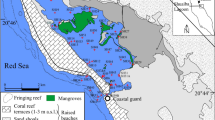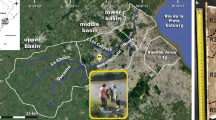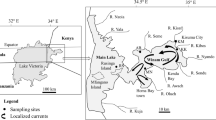Abstract
This study aimed to assess the spatial and seasonal distribution and anthropogenic sources of trace elements (Li, Be, Al, V, Cr, Co, Ni, Cu, Zn, Se, Mo, Ag, Cd, Sb, Ba, Tl, Pb, and U) by ICP-MS in the Ave River lower basin, Portugal. Mean values (µg L−1) of Al (2384), Zn (55.3), Se (34.6), Cu (24.7), Pb (12.7), Ag (0.75), and Cd (0.66), exceeded the water quality guidelines for the protection of aquatic life. The decreasing order of trace elements concentrations in surface water and sediments was, respectively: Al > Zn > Se > Mo > Li > Ba > V > Cu > Pb > Ni > Cr > U > Be > Co ≈ Sb > Ag ≈ Cd > Tl; and Al > Zn > Li > Ba > Cu > Pb > Cr > V > Ni > Co > U > Be > Se ≈ Mo ≈ Tl ≈ Cd ≈ Sb ≈ Ag. Moreover, the concentrations of nitrate values were higher than 50 mg L−1. To distinguish natural from anthropogenic sources, the geo-accumulation index (Igeo) and the enrichment factor (EF) of sediments were determined. Igeo revealed high contamination by Al, Mn, Ba and Zn, while EF evidenced enrichment for Se, Cd, Zn, Li, Cu, Ag, Pb and U. Bioaccumulation factors (BF) in flora suggested that macroalgae, Medicago marina L. and Plantago lanceolata L., might be accumulators of Se, Mo, Ba and Pb (BF > 1). The highest translocation factor (TF) was found for Mo in leaves (33.6) and flowers (28.1) of P. lanceolata L..
Article Highlights
-
The present work regards a comprehensive study on the occurrence, spatial distribution, possible sources and bioaccumulation of trace elements in this ecosystem, namely in water, sediments and native local flora (plants and macroalgae). In fact, various studies have demonstrated the high anthropogenic pressure of Ave River estuary, the presence of several classes of pollutants and the negative impacts in local aquatic organisms. Nevertheless, there are no studies regarding the monitoring of a large panel of trace elements considering three different matrices (water, sediments and plants) and their possible correlation
-
Pollution indices such as geo-accumulation (Igeo) and enrichment factor (EF) were also determined to investigate sources of these elements. Igeo revealed high contamination by Al, Mn, Ba and Zn, while EF evidenced enrichment for Se, Cd, Zn, Li, Cu, Ag, Pb and U. Bioaccumulation factors (BF) in flora suggested that macroalgae, Medicago marina L. and Plantago lanceolata L. might be accumulators of Se, Mo, Ba and Pb
-
These monitoring data are important to alert local and national authorities to take actions and decisions to protect and improve water quality of Portuguese waterbodies and meet national and European requirements






Similar content being viewed by others
References
Allen SE (1989) Chemical analyses of ecological material, 2nd edn. Blackwell Scientific Publications, London
Alves CM, Boaventura RRAR, Soares HMVM (2009) Evaluation of heavy metals pollution loadings in the sediments of the Ave River Basin (Portugal). Soil Sediment Contam 18(5):603–618
Alyazichi YM, Jones BG, McLean E (2015) Spatial distribution of sediment particles and trace element pollution within Gunnamatta Bay, Port Hacking, NSW, Australia. Reg Stud Mar Sci 2:124–131
Alyazichi YM, Jones BG, McLean E, Pease J, Brown H (2017) Geochemical assessment of trace element pollution in surface sediments from the Georges River, Southern Sydney, Australia. Arch Environ Contam Toxicol 72:247–259
Amare TA, Yimer GT, Workagegn KB (2014) Assessment of metals concentration in water, sediment and macrophyte plant collected from Lake Hawassa, Ethiopia. J Environ Anal Toxicol 4:247
Ansari AA, Gill SS, Gill R, Lanza GR, Newman L (2016) Phytoremediation: management of environmental contaminants, vol 3. Springer, Switzerland
Barbieri M (2016) The importance of enrichment factor (EF) and geoaccumulation index (I geo) to evaluate the soil contamination. J Geol Geophys 5:1
Basta NT, Ryan JA, Chaney RL (2005) Trace element chemistry in residual-treated soil: key concepts and metal bioavailability. J Environ Qual 34:49–63
Brautigan DJ, Rengasamy P, Chittleborough DJ (2012) Aluminium speciation and phytotoxicity in alkaline soils. Plant Soil 360:187–196
CCME-Canadian Council of Ministers of the Environment (2001) Canadian Sediment Quality Guidelines for the Protection of Aquatic Life, Updated. In: Canadian environmental quality guidelines, 1999, Canadian Council of Ministers of the Environment, Winnipeg. http://st-ts.ccme.ca/en/index.html. Accessed 05 Mar 2018
CCME-Canadian Council of Ministers of the Environment (2017) Water quality guidelines for the protection of aquatic life. http://st-ts.ccme.ca/en/index.html. Accessed 05 Mar 2018
Chen CW, Kao CM, Chen CF, Dong CD (2007) Distribution and accumulation of heavy metals in the sediments of Kaohsiung Harbor, Taiwan. Chemosphere 66:1431–1440
Clesceri LS, Greenberg AE, Eaton AD (1998) Standard Methods for the Examination of Water and Wastewater, 20th edn. American Public Health Association, Washington, DC
Combs GF, Combs SB (1986) The role of Selenium in nutrition. Academic Press, Orlando
Couto CMCM, Pinto I, Madureira TV, Rocha MJ, Tiritan ME, Lopes JA, Almeida AA (2014) Lower Douro River basin (Portugal) water quality—focus on trace element changes and anthropogenic sources of contamination. Global Nest J 16:251–268
Couto CMCM, Ribeiro C, Maia A, Santos M, Tiritan ME, Ribeiro AR, Pinto E, Almeida A (2018) Assessment of Douro and Ave River (Portugal) lower basin water quality focusing on physicochemical and trace element spatiotemporal changes. J Environ Sci Heal A. https://doi.org/10.1080/10934529.2018.1474577
Dan SF, Umoh UU, Osabor VN (2014) Seasonal variation of enrichment and contamination of heavy metals in the surface water of Qua Iboe River Estuary and adjoining creeks, South-South Nigeria. J Oceanogr Mar Sci 5:45–54
Directive WFD (2000) 2000/60/EC of the European Parliament and of the Council of 23 October 2000 establishing a framework for Community action in the field of water policy. Off J Eur Commun 1:72
Doležalová Weissmannová H, Pavlovský J, Chovanec P (2015) Heavy metal contaminations of Urban soils in Ostrava, Czech Republic: assessment of metal pollution and using principal component analysis. Int J Environ Res 9(2):683–696
Ebbs S, Brady D, Norvell W, Kochian L (2001) Uranium speciation, plant uptake, and phytoremediation, practice periodical of hazardous toxic and radioactive. Waste Manag 5:130–135
Feng H, Qian Y, Cochran JK, Zhu Q, Heilbrun C, Li L, Hu W, Yan H, Huang X, Ge M, Nazareski E, Chu YS, Yoo S, Zhang X, Liu CJ (2018) Seasonal differences in trace element concentrations and distribution in Spartina alterniflora root tissue. Chemosphere 204:359–370
Fitzgerald EJ, Caffrey JM, Nesaratnam ST, McLoughlin P (2003) Copper and lead concentrations in salt mash plants on the Suir Estuary, Ireland. Environ Pollut 123:67–74
Fonseca AR, Sanches Fernandes LF, Fontainhas-Fernandes A, Monteiro SM, Pacheco FAL (2017) The impact of freshwater metal concentrations on the severity of histopathological changes in fish gills: a statistical perspective. Sci Total Environ 1(599–600):217–226
Gjorgieva D, Kadifkova-Panovska T, Baceva K, Stafilov T (2011) Assessment of heavy metal pollution in republic of macedonia using a plant assay. Arch Environ Con Tox 60(2):233–240
Hamilton SJ (2004) Review of selenium toxicity in the aquatic food chain. Sci Total Environ 326:1–31
Hamzeha M, Ouddanea B, El-dayea M, Halwani J (2013) Profile of trace metals accumulation in core sediment from Seine river estuary (docks basin). Environ Technol 34(9):1107–1116
Hansel C, Fendorf S, Sutton S, Newville M (2001) Characterization of Fe plaque and associated metals on the roots of mine-waste impacted aquatic plants. Environ Sci Technol 35:3863–3868
Kabata-Pendias A, Pendias H (1992) Trace elements in soils and plants, 2nd edn. CRC Press, Boca Raton
Lenntech (2018) https://www.lenntech.com/periodic/water/silver/silver-and-water.htm. Accessed 17 Jun 2018
Magesh NS, Chandrasekar N, Elango L (2017) Trace element concentrations in the groundwater of the Tamiraparani river basin, South India: insights from human health risk and multivariate statistical techniques. Chemosphere 185:468–479
Malmström ME, Rolli V, Cui Q, Brandt N (2009) Sources and fates of heavy metals in complex, urban aquatic systems: modelling study based on Stockholm, Sweden, WIT transactions on ecology and the environment, vol 122. WIT Press, New York (ISSN 1743-3541 (on-line))
Mendiguchía C, Moreno C, García-Vargas M (2007) Evaluation of natural and anthropogenic influences on the Guadalquivir River (Spain) by dissolved heavy metals and nutrients. Chemosphere 69(10):1509–1517
Muller G (1969) Index of geo-accumulation in sediments of the Rhine River. Geo J 2:108–118
Oliveira RES, Lima MMCL and Vieira JMP (2005) An indicator system for surface water quality in river basins. The fourth inter-celtic colloquium on hydrology and management of water resources. http://www.aprh.pt/celtico/PAPERS/14.PDF. Accessed 26 May 2017
Parques e Vida Selvagem (2006) http://www.parquebiologico.pt/userdata/revistas/17-RevistaPVS-Outono.pdf, accessed 25/01/2018
Petrova S, Velcheva I, Yurukova L, Berova M (2014) Plantago lanceolata L. as a biomonitor of trace elements in an urban area. Bulg J Agric Sci 20(2):325–329
Prasad MNV, Freitas HMO (2003) Metal hyperaccumulation in plants—biodiversity prospecting for phytoremediation technology. Electron J Biotechn 6(3):276–312
Prasad MNV, Sajwan KS, Naidu R (2006) Trace elements in the environment: biogeochemistry, biotechnology, and bioremediation. Taylor and Francis, CRC Press, Boca Raton
Raskin I, Ensley BD (2000) Phytoremediation of toxic metals using plants to clean up the environment. Wiley, New York
Renjan S, Rao VP, Kessarkar PM (2017) Major and trace metals in suspended and bottom sediments of the Mandovi and Zuari estuaries, western India: distribution, source, and pollution. Environ Sci Pollut Res 24:27409–27429
Ribeiro CMR, Maia AS, Ribeiro AR, Couto C, Almeida AA, Santos M, Tiritan ME (2016) Anthropogenic pressure in a Portuguese river: endocrine-disrupting compounds, trace elements and nutrients. J Environ Sci Health A 51(12):1043–1052
Ribeiro C, Couto C, Ribeiro AR, Maia AS, Santos M, Tiritan ME, Pinto E, Almeida AA (2018) Distribution and environmental assessment of trace elements contamination of water, sediments and flora from Douro River estuary, Portugal. Sci Total Environ 639:1381–1393
Roy S, Labelle S, Mehta P et al (2005) Phytoremediation of heavy metal and PAH-contaminated brownfield sites. Plant Soil 272(1–2):277–290
Savitha P (2014) Role of selenium. J Pharm Sci Res 6(1):56–59
Soares HMVM, Boaventura RAR, Machado AASC, Esteves da Silva JCG (1999) Sediments as monitors of heavy metal contamination in the Ave river basin (Portugal): multivariate analysis of data. Environ Pollut 105(3):311–323
Summer K, Reichelt-Brushett A (2018) Trace element contaminant uptake in phytocap vegetation and implications for koala habitat, Lismore, Australia. Environ Sci Pollut Res 25:24281–24292
Sutherland RA, Tolosa CA, Tack FMG, Verloo MG (2000) Characterization of selected element concentrations and enrichment ratios in background and anthropogenically impacted roadside areas. Arch Environ Contam Toxicol 38:428–438
Tangahu BV, Sheikh Abdullah SR, Basri H, Idris M, Anuar N, Mukhlisin M (2011) A review on heavy metals (As, Pb, and Hg) uptake by plants through phytoremediation. Int J Chem Eng. https://doi.org/10.1155/2011/939161
U. S. Department of Energy (1994) Mechanisms of plant uptake, translocation, and storage of toxic elements. Summary Report of a workshop on phytoremediation research needs. http://www.osti.gov/bridge/purl.cover.jsp;jsessionid=D72C8DD9003DCF51984EE254A6ED8BCB?purl=/10109412-BckU4U/webviewable/. Accessed 16 May 2018
USEPA (2007) Method 3051A microwave assisted acid digestion of sediments, sludges, soils, and oils. USEPA, Washington, DC
Wedepohl KH (1995) The composition of the continental crust. Geochim Cosmochim Ac 59(7):1217–1232
Windham L, Weis JS, Weis P (2003) Uptake and distribution of metals in two dominant saltmarsh macrophytes, Spartina alterniflora (cordgrass) and Phragmites australis (common reed). Estuar Coast Shelf S 56:63–72
Woitke P, Wellmitz J, Helm D, Kube P, Lepom P, Litheraty P (2003) Analysis and assessment of heavy metal pollution in suspended solids and sediments of the river Danube. Chemosphere 51:633–642
Yang J-L, Zhang G-L (2015) Formation, characteristics and ecoenvironmental implications of urban soils—a review. Soil Sci Plant Nutr 61(sup1):30–46
Yin S, Yuehan W, Wei X, Yangyang L, Zhenyao S, Chenghong F (2016) Contribution of the upper river, the estuarine region, and the adjacent sea to the heavy metal pollution in the Yangtze estuary. Chemosphere 155:564–572
Acknowledgments
This work received financial support from the European Union (FEDER funds POCI/01/0145/FEDER/007265) and National Funds (FCT/MEC, Fundação para a Ciência e Tecnologia and Ministério da Educação e Ciência) under the Partnership Agreement PT2020 UID/QUI/50006/2013 and the Project PTDC/SAU-ESA/108871/2008. This work was also supported by CESPU, through Project MYCO-CESPU-2016, ChiralDrugs_CESPU_2017 and BIOENVIROM-CESPU-2018.
Author information
Authors and Affiliations
Corresponding author
Ethics declarations
Conflict of interest
On behalf of all authors, the corresponding author states that there is no conflict of interest.
Electronic supplementary material
Below is the link to the electronic supplementary material.
Rights and permissions
About this article
Cite this article
Maria Cavadas Morais Couto, C., Ribeiro, C., Ribeiro, A.R. et al. Spatiotemporal Distribution and Sources of Trace Elements in Ave River (Portugal) Lower Basin: Estuarine Water, Sediments and Indigenous Flora. Int J Environ Res 13, 303–318 (2019). https://doi.org/10.1007/s41742-019-00174-z
Received:
Revised:
Accepted:
Published:
Issue Date:
DOI: https://doi.org/10.1007/s41742-019-00174-z




